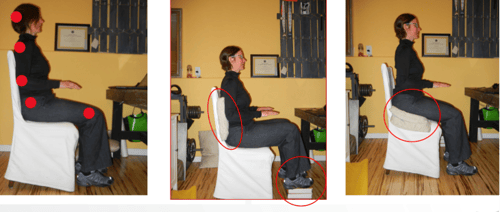Share this
3 steps to make your office space work for you
by Alex Bronk on October 1, 2022
 For many of us, working at a desk (whether in a company office or at home) is a standard part of our jobs. But is your office set up in a way that works for you? That’s where ergonomics can help!
For many of us, working at a desk (whether in a company office or at home) is a standard part of our jobs. But is your office set up in a way that works for you? That’s where ergonomics can help!
Have you ever noticed how a comfortable chair helps you feel more relaxed, more focused, and less sore afterward? Well, science shows that an office environment that is set up to meet a worker’s physical needs helps prevent injuries that can be caused by awkward posture. In fact, one study noted that providing ergonomically acceptable workstations and seating helped improve productivity by 15%.
As you can imagine there are lots of areas to consider in workspace ergonomics, like what equipment to use and how best to set it up. The reality is that ergonomics is about you, what you have available, and the alternative solutions you can use if you need to try something different. Ergonomics also includes how you take care of your body with breaks, movements, and more.
First, keep these main considerations in mind:
- Your posture: how you stand or sit and what pressure you feel in your body
- Repetition: the number of times a movement is repeated
- Time: The length of time someone performs a task
- General environment: how warm or cold the room is and the lighting
 Next, consider your workspace equipment:
Next, consider your workspace equipment:
- Work surface: Traditional desk, adjustable desk, table, or countertop
- Seat: Traditional chair, adjustable chair, or something else
- Technology: Laptop, desktop computer, keyboard, mouse, monitor, docking station, tablet, or stylus
Breaking down ergonomics
Posture Scan: Standing and Seated
Start with a Posture Scan, or the way you measure your neutral posture and how your posture makes your body feel. It's also great to check your posture during your workday to see how your body is doing. A neutral posture allows our bodies to be in the best position, with fewer forces and more opportunities for our muscles, joints, blood vessels, and nerves to be in good positions. Learn how you can conduct your own posture scan.
Setting up your workspace
Next, we’re going to build upon what you learned from your Posture Scan by setting up your workspace to meet your needs. If you need support for this next part, see if you can have a second person observe your posture. Alternatively, put a mirror next to you, so you can observe yourself. Check out these simple ways to adjust your workspace to make it work for you.

Moving, stretching, and massages
Another key part of ergonomics is moving your body. Even with a workspace that supports your ideal position, we need movement to nourish our bodies. These movements, stretches, and self-massages are great preventative measures you can incorporate into your self-care routine.

Choose movements that work for you, whether it’s moving just a little or a lot, seated or standing, and for as many times as you want. As you build your routine, don’t forget to stretch to help reduce tension. Also, consider giving yourself a massage as another way to relieve tension and bring back blood flow to a certain area. Find out what you can add to your routine.
Resources
For more information, check out these resources:
- Computer Workstation Ergonomic eTool
- Video Solutions Series | The Back School
- Jumping Jacks: Benefits, Risks, in Pregnancy, How to, and More | healthline.com
- Ergonomics Assessment Materials | The Back School
- Self-Massage: How to Massage Your Neck, Head, Back, and More | healthline.com
- How to Self-Massage Your Trapezius Muscle | verywellhealth.com
- Home Office Ergonomics: Tips, Products, and Exercises | verywellhealth.com
- 7 must-have ergonomic upgrades for your home office | CNET
- 4 Best Office Chairs of 2022 | CNET
- Best standing desk converter for 2022 | CNET
- Best standing desk for 2022 | CNET
Share this
- Employer (78)
- Program Tips (63)
- Wellbeing (57)
- International (46)
- Health Plans (27)
- Health Systems (26)
- Health (21)
- Staying Healthy & Safe (16)
- VP Activate (15)
- Webinars (12)
- Production Campaigns (11)
- Thrive Summit (11)
- Toolkits & Guides (8)
- Success Stories (7)
- Embracing Diversity (6)
- Mental health (2)
- April 2024 (1)
- March 2024 (2)
- February 2024 (1)
- January 2024 (5)
- December 2023 (2)
- November 2023 (1)
- October 2023 (3)
- September 2023 (4)
- August 2023 (6)
- July 2023 (4)
- June 2023 (2)
- May 2023 (1)
- April 2023 (4)
- March 2023 (1)
- February 2023 (1)
- January 2023 (1)
- December 2022 (2)
- November 2022 (7)
- October 2022 (10)
- September 2022 (6)
- August 2022 (9)
- July 2022 (2)
- June 2022 (9)
- May 2022 (6)
- March 2022 (1)
- January 2022 (1)
- December 2021 (1)
- November 2021 (1)
- October 2021 (2)
- September 2021 (2)
- August 2021 (1)
- July 2021 (1)
- June 2021 (3)
- April 2021 (6)
- March 2021 (1)
- February 2021 (3)
- January 2021 (3)
- December 2020 (2)
- November 2020 (2)
- October 2020 (2)
- September 2020 (3)

No Comments Yet
Let us know what you think